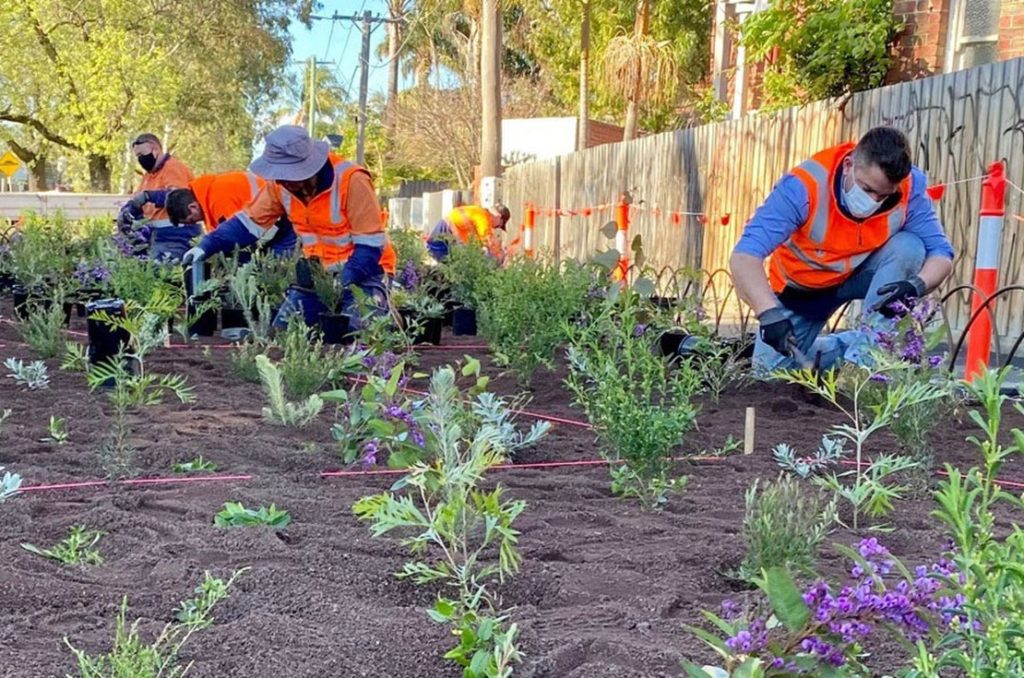Corridors of habitat enhancing biodiversity in the City of Port Phillip
Urban biodiversity is under threat throughout Melbourne and although the City of Port Phillip has many leafy green boulevards and some large urban parks, loss of backyard vegetation was reducing the ability for animals to move safely through the City to access food and shelter.
In 2019, volunteer ornithologists mapped potential biolinks to link fragmented bird populations through the City. In response, Council has looked at how vegetation on private property can be protected and enhanced as well as how public land can be further vegetated.
In 2019, Council began work on the Danks St Biolink with community involvement in the design and plant selection to support local bird species.
The Danks St median extends through Albert Park and Port Melbourne. In an ongoing project, lawn areas of Danks Street are replaced with native plants and organic mulch. Bird baths and nesting boxes support bird populations and hollow logs provide ground storey habitat. So far, the transformation of Danks St includes 172 native trees from 39 different species, 5,590 new native plants, 15 bird baths, 32 nesting boxes and numerous hollow logs. When complete the project will comprise 20,000 grasses and flowering shrubs.
Volunteer ornithologists conduct monthly bird surveys and the Biolink now acts as an outdoor classroom for nearby Albert Park College students who monitor the animal populations and vegetation and fill bird baths over summer.
Council is also working with the University of Melbourne researchers top create a woody meadow in Balaclava. This diverse planting of woody shrubs and small trees will be maintained by hard pruning every 2-3 years to promote flowering. This process replicates the natural plant response to fire so that plants re-sprout and reseed to create more density. Requiring less maintenance and water, this woody meadow is a great way to cost- effectively manage complex open spaces.
Council will continue working with the community to identify biolinks, improve vegetation and provide diverse landscapes for animals across the City.
Themes and Local Areas
| Primary Theme: | Native vegetation |
| Other Themes: | Native Animals, Communities |
| Primary Local Area: | Urban Melbourne |
| Other Local Areas: | – |
| Project location: | Danks Street, Albert Park. Balaclava. |
| Scale of the project: | Local |
| New or continuing work: | Continuing/building on previous work |
Project partners
| Lead organisation: | City of Port Phillip |
| Key partners: | University of Melbourne, Albert Park College |
| Registered Aboriginal Party/s relevant to the project or its area: | Bunurong Land Council Aboriginal Corporation |
Investment opportunities
| Opportunities for investors within this project start from: | $$ (Tens of thousands of dollars) |
| Estimated scale of investment for full project implementation: | $$$ (Hundreds of thousands of dollars) |
| Estimated timeframe for full project implementation: | 2-10 years |
Contribution toward targets
| Primary Regional Catchment Strategy target and contribution to its achievement: | Major new biolinks – Significant, sustained revegetation programs have been undertaken from 2021 to 2050 and have created numerous major biolinks in priority locations across the region |
| Relevant Biodiversity 2037 goal: | Support people connect with nature |
| Relevant National Landcare Program priority: | – |
More information
Biodiversity blossoms in Balaclava – The City of Port Phillip



